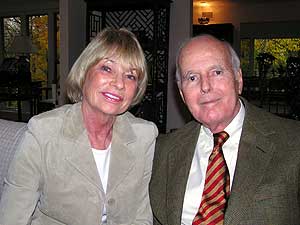|
Audio
Photos
Your Voice
|
New Chinese galleries at MIA filled with gifts by Ruth and Bruce Dayton
October 29, 2004
 |
| Bruce and Ruth Dayton have donated more than $20 million in Chinese art to the MIA. (MPR Photo/Lorna Benson) |
Minneapolis, Minn. — Bruce Dayton made his fortune working for his family's retail empire - the Dayton's Department Stores. For most of his 85 years, he's also been a devoted arts patron. At age 23, Dayton was named an MIA trustee. Soon afterward, he began making frequent trips to Europe to scout out works to add to the museum's collection. He was especially fond of French Impressionists.
But Dayton's focus abruptly changed in the mid-1980s, when he started dating his future wife, Ruth. "Paris is his town and we enjoyed it," says Ruth. "But I was anxious to try another venue."
 | |||
Ruth longed to see China. She had been practicing tai chi for many years. She had even studied Eastern philosophy with a Chinese master. But she had never been there. Nor had Bruce. "I was tremendously impressed with China and so we decided if we're going to do art together we ought to do Chinese art," says Bruce.
They began collecting furniture, mainly because they didn't want to compete with the MIA's already sizable collection of Chinese bronzes, jades, and textiles donated by Alfred Pillsbury in the 1950s. Also, China's communist government didn't restrict exporting furniture at that time, so Bruce Dayton was able to buy several royal chairs that would be nearly impossible to purchase in today's art market.
Ruth says she has always had great respect for her husband's artistic eye. But on one occasion, she had to insist that he buy a particular chair for the MIA. "I was taken with it primarily because it was called The Drunken Lord's Chair," says Ruth. "I'm from Windom, Minnesota and sort of a commoner and wanted to balance all of the Imperial things in our collection with a drunken lord's chair."
 | |||
Ruth got her way and they bought the chair. MIA Chinese Art Curator, Bob Jacobsen, was with the Daytons that night. Not surprisingly, he spends a lot of time with his biggest donors, offering them advice on their purchases. On this fall afternoon he's standing in their living room, surveying bamboo bookcases filled with rare objects - some of which travel between the Dayton's home and the MIA.
"I do have to take a few things back with me today. You know that don't you?" Jacobsen asks with a smile.
"I was just thinking about that," Ruth Dayton responds.
The couple embark on what seems to be a familiar routine.
"You got the bubble wrap?" Jacobsen asks.
"Well, we can find some," Ruth Dayton laughs
The MIA's Bob Jacobsen says the Daytons are extraordinary donors because they always give him the first pick of their treasures and they don't only buy art that appeals to their personal tastes.
 | |||
"Most private collectors will understandably collect things they are interested in," says Jacobsen. "What really makes Bruce and Ruth exceptional is that they have a totally open mind, are curious about almost every aspect of Chinese art and it's the only way they would have allowed us as a museum or me as a curator to develop six collections, simultaneously. That hardly ever happens in this field."
Besides furniture, the Dayton's have also bought Chinese books, scrolls, and classical paintings, ceramics, Tibetan art and ancient lacquer items. They've donated more than 700 objects since 1990, totaling well over $20 million. But Bruce Dayton doesn't think those numbers are worth mentioning.
"It's not important," says Bruce. "You want people to appreciate the art rather than seeing the dollar figure attached to it."
Dayton will say that it was important that he and his wife started collecting Chinese art when they did. In just a little over a decade, prices have increased almost ten-fold. That's because the Chinese have become much more interested in their own cultural history and are now competing with Western buyers.
|
News Headlines
|
Related Subjects
|
